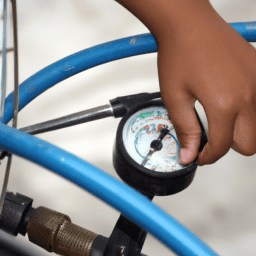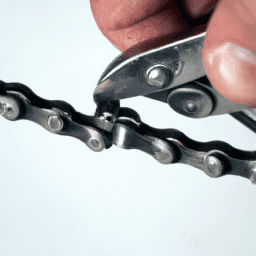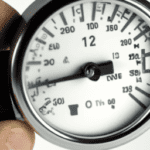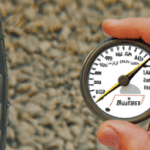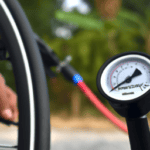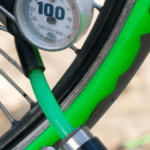Were you aware that the proper tire pressure in your bike tires can significantly influence your cycling experience? As per a research article from Bicycling Magazine, it’s found that ‘over 90% of riders have the wrong tire pressure.’
This statistic highlights the importance of understanding how much air should be in your bicycle tires. Proper tire pressure can improve your bike’s handling, prevent flats, and even make your ride smoother.
But how do you know how much air to put in your tires? In this article, I will guide you through the process of determining the recommended tire pressure for your bike, factors that affect tire pressure, and how to measure and adjust your tire pressure using a tire pressure gauge.
By regularly checking and maintaining proper tire pressure, you can have a safer and more enjoyable ride.
Key Takeaways
- The recommended tire pressure can vary depending on the type of tire and weight of the rider.
- Underinflating can result in poor handling and increased rolling resistance, as well as the risk of tire blowouts.
- A tire pressure gauge is essential for maintaining proper tire pressure, and accuracy and reliability of the gauge is crucial.
- Proper tire pressure ensures optimal handling and maneuverability of the bike, better traction and grip on the road, and minimizes wear and tear on tires, which can extend their lifespan.
Understand the Importance of Proper Tire Pressure
Proper tire pressure is crucial for a smooth ride and preventing unnecessary wear and tear on your bike, so it’s important to know how many pounds of air your bicycle tire needs.
The benefits of keeping your tire pressure at the recommended level include better handling, increased efficiency, and reduced risk of punctures. On the other hand, riding with improper tire pressure can lead to a bumpy ride, decreased control, and even damage to your rims.
It’s important to note that the recommended tire pressure can vary depending on the type of tire and the weight of the rider. Overinflating your tires can lead to a harsh ride and increased risk of punctures, while underinflating can result in poor handling and increased rolling resistance.
In the next section, we’ll discuss how to determine the recommended tire pressure for your bike and ensure you’re getting the best performance out of your ride.
Determine the Recommended Tire Pressure for Your Bike
Want to make sure your bike rides smoothly and efficiently? Check the recommended tire pressure! Calculating the correct PSI for your bike’s tires can make a big difference in how it handles and performs. The recommended tire pressure can usually be found on the sidewall of the tire, but it’s important to double-check with your bike’s manual or the manufacturer’s website to ensure accuracy.
When calculating PSI, it’s important to take into account your weight, the weight of any cargo you may be carrying, and the type of terrain you’ll be riding on. To help visualize this, imagine a table with three columns: weight, cargo, and terrain. Under each column, there are three rows for light, medium, and heavy. For example, if you weigh 150 pounds, are carrying a medium amount of cargo, and will be riding on smooth pavement, the recommended PSI may be around 50. It’s also important to choose the appropriate valve for your bike’s tires, either a Presta or Schrader valve, to ensure that you can properly inflate them.
Now that you know how to determine the recommended tire pressure for your bike, it’s important to consider factors that affect tire pressure, such as temperature changes and punctures. By regularly checking and adjusting your tire pressure, you can ensure a smooth and safe ride.
Consider Factors That Affect Tire Pressure
To maintain optimal tire pressure, you should keep in mind that your bike’s tires are affected by various factors, like a living organism. Tire construction plays a crucial role in determining the pressure level, as different types of tires require varying levels of pressure.
Additionally, temperature effects can cause tire pressure to fluctuate. Hot temperatures lead to higher pressure, while cold temperatures lead to lower pressure. Altitude also impacts tire pressure, with higher altitudes requiring lower pressure due to the thinner air.
Moreover, the type of valve used in your bike’s tire can also impact the pressure level. Presta valves require higher pressure than Schrader valves, and it is crucial to ensure you are using the correct pressure for your valve type.
Keeping all these factors in mind can help you maintain the optimal tire pressure for your bike, ensuring a better grip on the road and a smoother ride. With these factors in mind, you can now move on to the next step of using a tire pressure gauge to measure and adjust tire pressure.
Use a Tire Pressure Gauge to Measure and Adjust Tire Pressure
Get ready to measure and adjust your tire pressure using a gauge – it’s easy and quick! One of the most important tools for maintaining proper tire pressure is a tire pressure gauge. It’s essential to use a gauge that’s accurate and reliable.
Here are some tips to help you get started:
- Purchase a high-quality tire pressure gauge that’s easy to read and use.
- Make sure the gauge’s calibrated regularly to ensure accuracy.
- Check the manufacturer’s instructions to determine the recommended tire pressure for your bike.
- Measure the pressure in each tire and adjust as needed.
Tire gauge accuracy is crucial when it comes to maintaining proper tire pressure. Alternative methods such as using your finger or a foot pump can be inaccurate, leading to under or over-inflated tires. By using a tire pressure gauge, you can ensure that your tires are inflated to the correct pressure, which can prolong their lifespan and make your ride smoother.
Regularly checking and maintaining proper tire pressure is a simple yet essential step in bike maintenance.
Regularly Check and Maintain Proper Tire Pressure
Maintaining proper tire pressure is crucial for a smooth and safe ride, so make sure you regularly check and adjust your tire pressure using a reliable gauge. The benefits of correct inflation are numerous. For one, it ensures optimal handling and maneuverability of your bike. When the tire is properly inflated, it allows for better traction and grip on the road, which is especially important when making sharp turns or sudden stops. Additionally, proper tire pressure helps to minimize wear and tear on your tires, which can extend their lifespan.
On the other hand, the risks of underinflation are significant and should not be overlooked. When a tire is underinflated, it can lead to poor handling and control of your bike, making it more difficult to steer and handle. This can increase the risk of accidents and injuries. Furthermore, underinflated tires can cause increased rolling resistance, which means that your bike will require more effort to move forward and can result in decreased speed and efficiency. In the worst cases, underinflation can cause tire blowouts, which can be dangerous and costly to repair. By regularly checking and maintaining proper tire pressure, you can ensure a smooth and safe ride, and avoid the potential risks associated with underinflation.
| Benefits of Correct Inflation | Risks of Underinflation | ||
|---|---|---|---|
| Optimal handling and maneuverability | Poor handling and control | ||
| Better traction and grip on the road | Increased rolling resistance | ||
| Minimize wear and tear on tires | Tire blowouts | ||
| Extended lifespan of tires | Increased risk of accidents and injuries | ||
| Increased speed and efficiency | Increased speed and efficiency, but at the cost of safety and potential damage to the vehicle. |
Frequently Asked Questions
What is the maximum weight limit for a bicycle tire?
As a technical expert, I can tell you that the maximum weight capacity of a bicycle tire depends on its size and type. To ensure tire durability, it is important to choose the right tire for your bike and to maintain proper air pressure.
How often should you replace your bicycle tire?
Replacing bicycle tires is crucial for optimal performance and safety. The tire lifespan varies based on usage, terrain, and tire quality. Regular inspections and replacements at the first sign of wear are important.
Can using a different brand of inner tube affect tire pressure?
Using a different brand of inner tube can affect tire pressure due to brand compatibility. It’s important to ensure inflation consistency between the tire and inner tube to avoid issues such as uneven wear and decreased performance.
Is there a difference in recommended tire pressure for road bikes versus mountain bikes?
As a cyclist, I know the importance of tire pressure for performance. Proper tire pressure for different terrains is key. While road bikes require higher pressure, mountain bikes need lower pressure to better absorb shocks and maintain traction.
How does temperature affect tire pressure?
Temperature affects tire pressure by changing the volume of air in the tire. As temperature increases, air expands and tire pressure increases. Conversely, as temperature decreases, air contracts and tire pressure decreases. Altitude also affects tire pressure due to changes in atmospheric pressure.
Conclusion
In conclusion, it’s crucial for every cyclist to understand the importance of proper tire pressure. As I took my bike out for a ride, I realized the difference between a properly inflated tire and an underinflated one. The former felt smooth and effortless, while the latter was sluggish and difficult to maneuver.
Therefore, it’s essential to determine the recommended tire pressure for your bike and consider factors that affect it. Using a tire pressure gauge to measure and adjust tire pressure is a simple task that can make a world of difference in your biking experience.
Remember to regularly check and maintain proper tire pressure to ensure a safe and comfortable ride. Happy cycling!
